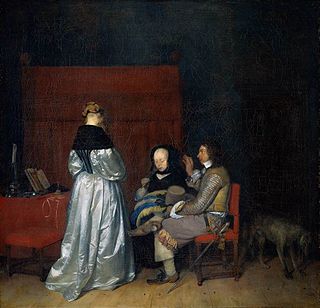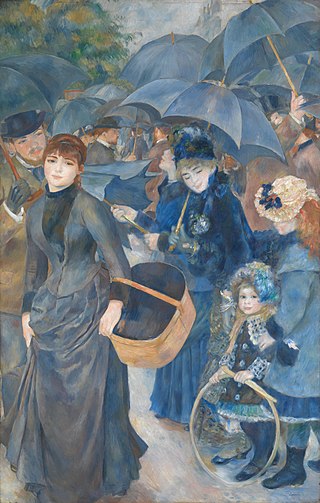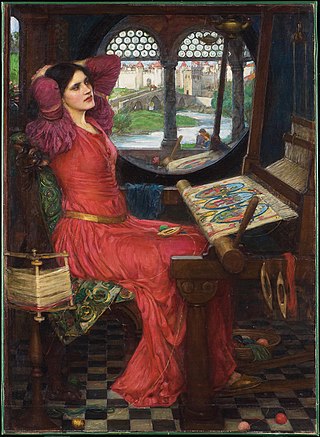
The Salon des Refusés, French for "exhibition of rejects", is generally known as an exhibition of works rejected by the jury of the official Paris Salon, but the term is most famously used to refer to the Salon des Refusés of 1863.

The Arnolfini Portrait is an oil painting on oak panel by the Early Netherlandish painter Jan van Eyck, dated 1434 and now in the National Gallery, London. It is a full-length double portrait, believed to depict the Italian merchant Giovanni di Nicolao Arnolfini and his wife, presumably in their residence at the Flemish city of Bruges.

Jacques Joseph Tissot, better known as James Tissot, was a French painter, illustrator, and caricaturist. He was born to a drapery merchant and a milliner and decided to pursue a career in art at a young age, coming to incorporate elements of realism, early Impressionism, and academic art into his work. He is best known for a variety of genre paintings of contemporary European high society produced during the peak of his career, which focused on the people and women's fashion of the Belle Époque and Victorian England, but he would also explore many medieval, biblical, and Japoniste subjects throughout his life. His career included work as a caricaturist for Vanity Fair under the pseudonym of Coïdé.

A Private View at the Royal Academy, 1881 is a painting by the English artist William Powell Frith exhibited at the Royal Academy of Arts in London in 1883. It depicts a group of distinguished Victorians visiting the Royal Academy Summer Exhibition in 1881, just after the death of the Prime Minister Benjamin Disraeli, whose portrait by John Everett Millais was included on a screen at the special request of Queen Victoria. The room is Gallery III, the largest and most imposing room at Burlington House.

John Reinhard Weguelin was an English painter and illustrator, active from 1877 to after 1910. He specialized in figurative paintings with lush backgrounds, typically landscapes or garden scenes. Weguelin emulated the neo-classical style of Edward Poynter and Lawrence Alma-Tadema, painting subjects inspired by classical antiquity and mythology. He depicted scenes of everyday life in ancient Greece and Rome, as well as mythological subjects, with an emphasis on pastoral scenes. Weguelin also drew on folklore for inspiration, and painted numerous images of nymphs and mermaids.

The Gallant Conversation is an oil-on-canvas painting from circa 1654 by Gerard ter Borch. A late 18th century French print of the work is titled The Paternal Admonition, apparently believing it showed a father reprimanding his daughter, but modern art historians see it as a conversation between two prospective lovers, either a discussion of a betrothal or, more likely, a customer propositioning a prostitute in a brothel. There are two versions made by the painter, one at the Rijksmuseum, in Amsterdam, and the other at the Gemäldegalerie Berlin. The two paintings are dated to around 1654. The Amsterdam version is 71 cm by 73 cm, with the extra centimeters on the right being taken up by a dog and a door. The dimensions of the Berlin painting is smaller, 70 by 60 cm.

Charles Sedelmeyer was an Austrian and French art dealer, collector, and publisher active in Paris from 1866, with premises at 6 rue de la Rochefoucauld.

Woman Reading a Letter is a painting by the Dutch Golden Age painter Johannes Vermeer, produced in around 1663. It has been part of the collection of the City of Amsterdam since the Van der Hoop bequest in 1854, and in the Rijksmuseum in Amsterdam since it opened in 1885, the first Vermeer it acquired.

Hotel Lobby is a 1943 oil painting on canvas by American realist painter Edward Hopper; it is held in the collection of the Indianapolis Museum of Art (IMA), in Indianapolis, Indiana, United States.

The Umbrellas is an oil-on-canvas painting by Pierre-Auguste Renoir, painted in two phases in the 1880s. It is owned by the National Gallery in London as part of the Lane Bequest but is displayed alternately in London and at the Dublin City Gallery The Hugh Lane. From May 2013 to 2019, it returned to Dublin for a six-year period. It is now in the National Gallery London.

I Am Half-Sick of Shadows, Said the Lady of Shalott is a painting by John William Waterhouse completed in 1915. It is the third painting by Waterhouse that depicts a scene from the Tennyson poem, "The Lady of Shalott". The title of the painting is a quotation from the last two lines in the fourth and final verse of the second part of Tennyson's poem:

The Swing is an oil-on-canvas painting made in the summer of 1876 by the French Impressionist artist Pierre-Auguste Renoir. The painting depicts model Jeanne Samary, Norbert Goeneutte, and Renoir’s brother Edmond. The painting combines eighteenth-century techniques with modern elements.

Woman with Basket of Beans a Kitchen Garden (1661) is an oil-on-canvas painting by the Dutch painter Pieter de Hooch. It is an example of Dutch Golden Age painting and is now in the Kunstmuseum Basel in Switzerland. The painting is notable for its depiction of Dutch almshouse architecture and its inclusion of a portrait on a window shutter, which has sparked debate about its meaning and De Hooch's possible social commentary.

Young Mother Sewing aka Little Girl Leaning on her Mother's Knee is a 1900 painting by the American artist Mary Cassatt. It is in the collection of the Metropolitan Museum of Art.

Portsmouth Dockyard is an 1877 oil painting by French artist James Tissot. It is a reworking of his 1876 painting On The Thames, which also depicts a man and two women in a boat. It measures 15.0 by 21.5 inches.

The Gallery of HMS 'Calcutta' (Portsmouth), also known as Officer and Ladies on Board HMS Calcutta, is an 1876 oil painting by the French artist James Tissot. It depicts two ladies in fashionable clothing and a young naval lieutenant, standing on the quarter gallery at the stern of the Royal Navy warship HMS Calcutta. The Tate Gallery in London holds the painting and measures 68.6 by 91.8 centimetres (27.0 in × 36.1 in).

Woman with Umbrella in Front of a Hat Shop is an oil-on-canvas painting executed in 1914 by the German painter August Macke. It depicts a woman peeking into a hat shop, painted in an Expressionist style. The painting is in the collection of the Museum Folkwang in Essen.

The Sacrifice of Iphigenia is a 1968 painting by the Belgian artist Paul Delvaux. Inspired by Iphigenia's sacrifice in Greek mythology, it depicts five people on a boardwalk. In the foreground are three women, two of whom might be the same person who watches herself, and behind them appears to be a scene of human sacrifice where a man overlooks a woman with an exposed breast.

Madame Georges Charpentier and Her Children is an 1878 oil on canvas painting by Pierre-Auguste Renoir. It depicts Marguerite Charpentier, a French salonist, art collector, and advocate of the Impressionists, and her children Georgette and Paul. The painting is held by the Metropolitan Museum of Art.



















